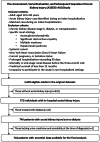Employing urinary biomarkers in predicting renal recovery three months after in-hospital acute kidney injury
- PMID: 40640106
- PMCID: PMC12247091
- DOI: 10.1080/0886022X.2025.2522975
Employing urinary biomarkers in predicting renal recovery three months after in-hospital acute kidney injury
Abstract
Introduction: Renal recovery after acute kidney injury (AKI) significantly improves outcomes. This cohort study explored the efficacy of six urinary biomarkers and the spot urine creatinine-to-osmolality ratio (sUCr/Osm) in predicting renal recovery 3 months after in-hospital AKI.
Methods: Data from the Assessment, Serial Evaluation, and Subsequent Sequelae of Acute Kidney Injury study, involving 744 patients with in-hospital AKI, were analyzed. The urinary biomarker with the highest area under the receiver operating characteristic curve (AUC) was selected as the representative for comparison. Renal recovery was defined as an absolute increase of <26.5 μmol/L or a relative elevation of <20% from the baseline serum creatinine (SCr) level at three months postdiagnosis.
Results: Among the 744 patients, 85.6% achieved renal recovery. Uromodulin demonstrated a greater AUC of 0.580 (95% CI: 0.518-0.641) than the other five biomarkers did. With a cutoff of 1,360 ng/mL, uromodulin sensitivity was 0.774 (95% CI: 0.741-0.806). The sUCr/Osm test exhibited high sensitivity (0.881; 95% CI: 0.856-0.906) with a cutoff of 8.84 (sUCr/Osm8.84) and high specificity (0.785; 95% CI: 0.707-0.863) with a cutoff of 21.22 (sUCr/Osm21.22). The positive predictive values of the three methods were approximately 0.880. The performance of these tests in predicting renal recovery based on both criteria in 298 patients with chronic kidney disease was also comparable.
Conclusion: Urinary biomarkers, especially uromodulin, and the sUCr/Osm test may be effective in predicting renal recovery three months after in-hospital AKI. The sUCr/Osm test may offer a more accessible approach for routine use, with sUCr/Osm8.84 demonstrating high sensitivity for screening and sUCr/Osm21.22 exhibiting high specificity for further discrimination.
Keywords: ASSESS-AKI; Acute kidney injury; prognosis; spot urine creatinine-to-osmolality ratio; uromodulin.
Conflict of interest statement
No potential conflict of interest was reported by the author(s).
Figures



References
-
- Zappalà S, Alfieri F, Ancona A, et al. Development and external validation of a machine learning model for the prediction of persistent acute kidney injury stage 3 in multi-centric, multi-national intensive care cohorts. Crit Care. 2024;28(1):189. doi: 10.1186/s13054-024-04954-8. - DOI - PMC - PubMed
MeSH terms
Substances
LinkOut - more resources
Full Text Sources
